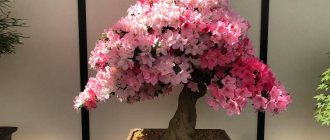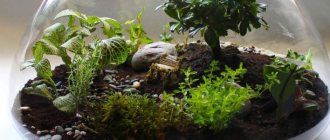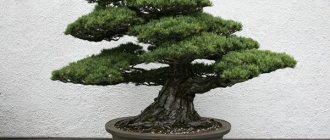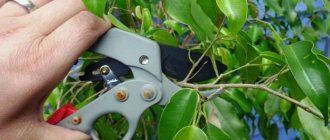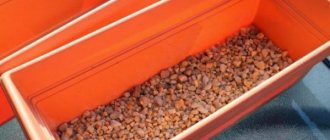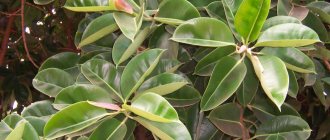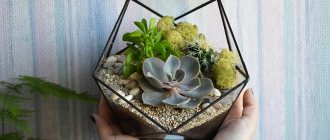How to choose a pot and soil
Many people are familiar with bonsai, but not everyone knows that in Chinese this word means “grown in a tray,” so there is no question of any deep pots. The container should be small, but equipped with drainage holes.
As for the soil, preference should be given to a light substrate that would freely allow both water and air to pass through.
It is best to use akadama, a red clay, for miniature trees. In the absence of one, you can buy a mixture for mulberry or palm trees at a flower shop.
Many gardeners prepare the soil themselves. It may consist of different components.
For example:
- Powdered clay, coarse river sand, fertile loam and peat chips are taken in equal proportions, and everything is mixed.
- Soil for ficus or palm trees (3 parts) is mixed with sand, vermiculite, perlite (1 part).
- Powdered clay (6 parts), leaf humus (1 part) and sand (3 parts) are also mixed together. Some people also add pine bark powder to this mass.
- Leaf humus (1 part), vermiculite or perlite (2 parts), expanded clay or pebbles (4 parts) and leaf soil (6 parts) will make a good base.
Transplanting into another pot
Transplanting into a new pot is a responsible undertaking. It should be carried out every two years, in the spring. You need to ensure the flower grows gradually, otherwise it may wither.
To transplant a flower you will need:
- Choose a new, larger pot.
- Prepare specialized soil.
- Transplant the flower into a new pot, water it and put it in a shaded place for a couple of weeks.
How to choose the right time?
The time of transplantation depends on the climate. Carefully monitor the condition of your flower: sometimes an emergency transplant is required, which will not depend on the season.
Basic rules for choosing the moment for transplantation:
- if you live in a hot climate, then replant the tree in March, without waiting for too bright sun;
- residents of the Middle Zone and more northern regions can be recommended to start transplanting no earlier than April;
- replanting a flower in the summer months is dangerous, during which time the tree is actively growing.
Choosing a pot and soil
An ordinary pot is not suitable for bonsai. You will need a special container that resembles a tray with legs. It looks very picturesque! A minimum of soil is placed in such a pot, but it is enough for a miniature plant.
What kind of pot should it be:
- made from natural materials (ceramic);
- it has one or more holes;
- It’s better if it’s on legs;
- you need to select a pallet of a suitable shape for it.
Peculiarity! Fertile soil can easily ruin your ficus. Buy a specialized bonsai mixture, such as red clay capsules.
Important nuances
In order for your bonsai at home to look like the picture, you need to pay attention to some points.
They are as follows:
- Ficuses in nature often grow on stony soil and rocks, reaching with their roots to the narrowest crevices. You can do something similar at home. To do this, it is enough to create several aerial roots that will cling to massive stones.
- Before placing stones under the roots, they must be lubricated with a mixture of powdered clay and soil. This manipulation will allow the root system to “suck” to the cobblestones, imitating the natural habitat. It should be remembered that it will be much easier to catch on rough stones.
- Bansai formation must be done correctly. Wrapping Ficus Benjamin with wire is an unsuccessful option and will lead to the destruction of fragile shoots.
- There is no need to cover the root part of the plant with pebbles, soil, moss, etc.
Popular types of ficus used for bonsai
The choice of this plant for creating a miniature tree is considered the most popular .
The types of ficus varieties are huge, with its help you can create incredible compositions and admire the bright spots. One such example is the most commonly used types:
- Ficus benjamina of all varieties;
- Ficus microcarpa.
There are a huge number of them; the variegated varieties of these plants delight with their foliage and spotty leaf blades. Here is one such option:
Using a variety of ficus microcarpas, you can plunge into the world of exoticism and beauty.
The most common type of creating tiny trees is the Benjamin ficus. Its openwork foliage and rapid growth dresses the crown in magnificent outfits.
Note : correctly selected varieties will reduce the cost of forming miniature trees.
Methods of forming bonsai
Forming a bonsai with your own hands is not difficult if you know certain rules and adhere to them.
Important! Bonsai is an entire art, so it is necessary to shape a tree by choosing a specific style and shape in advance.
Often, the ficus Benjamin, which can be found in any store, is taken as a basis, and a masterpiece is already made from it.
Namely:
- Moyogi. The rules for creating a tree of this type are simple. Considering that the trunk must bend in several places, you will need to take a couple of ropes and tie the base with them.
- Classic. If you want to make a Benjamin bonsai, but don’t have any special knowledge of how to do it, this method is perfect. In this case, the trunk of the tree should be smooth, and the crown should beautifully taper upward, resembling a pyramid. The bottom of the trunk remains bare.
- Yoseue. The formation of bonsai in this case is quite simple. 4-6 flowers are planted in one pot, which are turned into a kind of grove. If possible, plant trunks should have different thicknesses.
- Syakan. Growing a tree of this shape is very simple. The reason is that the trunk in this case should be strongly tilted in one direction, and the roots turned in the other.
- Sokan. Many, turning Ficus Benjamin into bonsai, confuse the previous technique with this one, although they are completely different. To shape the sokan, you will need to wait until the trunk bifurcates into two unequal parts. Considering that they may have to wait quite a long time for the “baby,” many simply plant a second flower, thus solving a difficult problem.
- Hokidachi. This is an unusual shape that resembles a broom. When creating such a tree, it is important to pay attention to the symmetry of the branches diverging to the sides from the trunk.
Regardless of what shape was chosen, the formed flower will look incredibly beautiful, because it was made by hand.
Why and when can you prune ficus benjamina?
Pruning for Ficus Benjamin can be sanitary, rejuvenating and formative. The first two have a positive effect on the condition of the plant itself, and the latter makes it highly decorative.
Important! It is extremely undesirable to carry out pruning operations (except for sanitary ones) in the autumn-winter period. This weakens the ficus, and it may begin to develop one-sidedly.. The optimal time for pruning work is the beginning of spring, when the dormant period ends and the plant begins to actively develop.
The optimal time for pruning is the beginning of spring, when the dormant period ends and the plant begins to actively develop.
How to grow a bonsai from a ficus
Many people believe that growing ficus bonsai is a very difficult task. In fact, by doing everything step by step, you will be able to achieve your goal without any problems.
Growing bonsai consists of the following points:
- In trimming. Some experienced gardeners immediately begin by saying: “Take a few small cuttings from the top of the plant, and then treat the cut areas with charcoal.” And this will be a true statement and the initial stage. Next, you will need to dry these cuttings and place them in a solution of a root formation stimulator or simply in water.
- In temperature. Without the proper temperature, no ficus bonsai will grow. The ideal option would be a mark on the thermometer of +25 ºС..+27ºС. Don't forget about good lighting.
- In choosing a container. No need to choose a large container. Having found a suitable container, you will need to lay material in the form of a mesh with small cells on the bottom, and pour coarse river sand (no more than 0.5 cm) and a couple of centimeters of soil on top.
- In landing. The plant is carefully placed in the substrate, and small stones are placed under the roots. The end result should be a small mound. In this case, it is important to ensure that the substrate does not reach the top edge of the pot. As for the root collar, it should be placed at the same level with the ground.
- In watering. When making a ficus benjamina bonsai with your own hands, it is important not to forget to water the plant. The first time the manipulation should be carried out half an hour after the transplant, and later - as necessary.
- In decoration. By planting several cuttings in one container, in the early stages they can be intertwined with each other.
Important! Weaving will not negatively affect the flower!
- First you will need to use ropes. When the trunk becomes woody, they can be removed.
- In creating beautiful roots. After the flowers have rooted, usually after 3-4 months, you will need to rake the substrate from the roots. Such manipulation does not harm the ficus at all, so you don’t have to worry about it.
- In crown formation. After six months, you can form a bonsai. To do this you will need to pinch the top.
- In decor. In order to decorate the pot and the plant itself, you can and even should use colored pebbles, moss, and some unusual stones. True, you shouldn’t get too carried away, otherwise the ficus won’t be visible because of all this tinsel.
As for how to make a bonsai from ficus benjamina, it has been partially described. Partly because it is important to be aware of pruning, which is a key point in the creation of a "Japanese tree".
Possible problems when growing bonsai
Any mistakes made by a bonsai grower negatively affect the appearance of the tree, which dramatically loses its decorative value. “Miniature”, unlike normal-sized trees, can die almost instantly. Therefore, measures must be taken promptly, immediately and correctly responding to the signals sent by the plant.
Table: common difficulties when growing ficus bonsai
| Description of the problem | What is the reason and what to do? |
| The leaves darken, become covered with gray spots of irregular shape, which quickly increase in size, then “crawl” onto the trunk. The soil becomes moldy and overgrown with moss. | The bonsai is watered too often and/or too much. Let the soil in the pot dry out, adjust the intervals between watering depending on the temperature and air humidity level outside and indoors. In especially severe cases, only a transplant will help. The bonsai is removed from the pot, the soil is shaken off from the roots, and the remains are washed off. All affected roots are cut off. The ficus is transplanted into new soil and a clean pot, sprinkling the roots with any product that stimulates their growth. The bonsai is sprayed with a 1–1.5% solution of any fungicide, tied in a bag for 10–15 days, with several holes made in the lower part to “dump” moisture. Then you need to keep the same number of mini-ficus in the open bag. |
| The leaves droop, lose their tone, fade and fall off. The bark gathers into folds. | Bonsai suffers from lack of moisture and dries out. To quickly and evenly wet the soil, place the pot for 10–15 minutes (until bubbles appear on the surface) in a large container of water, then place it in a plastic bag and tie it, thus raising the air humidity. Leave for 2-3 days. |
| Sudden and massive leaf fall. | Possible reasons are the use of water at an inappropriate temperature for irrigation (most often too cold), lack of light, incorrect location (in a draft). |
| The leaves curl and dry out, starting from the tips. | Bonsai receives too much bright light. Choose a place where the ficus will be protected from direct sunlight. If there is no alternative, shade the plant at a time when the sun is most active. |
| After watering, water takes a long time to leave the soil surface. | In this way, the bonsai signals the need for replanting. Or an unsuitable, too “heavy” soil was used. Approximately 4/5 of the substrate is removed from the pot, without touching the soil directly at the roots, and replaced with a more suitable one. Until the next convenient moment for replanting, the tree is placed in a larger pot, with sand sprinkled on the bottom. The soil is regularly loosened. |
Growing bonsai is an activity that requires patience, constant monitoring of the condition of the tree, artistic taste and imagination. Ficus is a good material for those wanting to practice before moving on to growing traditional miniature pines and maples. The plant is not capricious, responds gratefully to care, lends itself well to shaping and has the necessary decorative effect. Bonsai is a “long-term” hobby; growing a tree according to all the rules takes more than 10 years, the result will not be seen immediately, but observing the changes in shape and directing them in the right direction is very exciting.
Methods for pruning ficus
Usually the procedure begins with aerial roots, giving them the proper appearance. To create a lush crown, you need to regularly trim the main trunk. This leads to the fact that it increases in diameter, and the crown, in turn, becomes wider.
Important! Formation begins only when the trunk is thick and strong enough.
Taking into account the fact that ficus quickly “grows” leaves, pruning should be done at least once every six months. Branches on which up to 10 new leaves have appeared are shortened so that ultimately no more than 4 leaf blades remain. Trim the tree starting from the bottom. The juice that appears in the cut areas is not rubbed with anything.
The mistake of many is that they cut off only the leaf plates. The tree grows, new branches appear, but there is no bonsai as such, because gardeners have created a “naked” plant, and not a masterpiece.
If there is too much green mass, you can remove it a little, but only in early spring. Until autumn, only minor adjustments should be made aimed at maintaining the shape of the tree. From October to March, the flower is not touched, because at this time it enters the dormant stage.
As for the shape of the trunk, creating the desired one will not be difficult. Experienced gardeners recommend using twine, which can be used to tie the necessary branches to the base.
As already mentioned, wire is a bad option. However, if you can’t find anything else, then you will need to take the thinnest one and put some soft fabric under it.
Wrapping after transplantation should not be done earlier than 4 weeks later. After this period has expired, you can begin manipulation. To do this, you will need to strictly move from bottom to top. After 1.5-2 months, when it is possible to obtain the desired shape, it is necessary to cut the wire.
Step-by-step instructions for forming a plant
How do flower growers achieve miniature tree sizes? Actually, it's not that difficult. The main principle is limiting growth. Constant pruning of the roots and crown is carried out, plus the tree is planted in a very small pot.
Scheme of actions for the formation of bonsai:
- Planting the shoot in a special container.
- Root pruning as the root system develops.
- Modeling the trunk (as it grows).
- Giving the crown the desired shape through constant pruning.
- Replant the plant every two years.
Crown
You need to form a crown on plants that are already strong. The tool for crown formation is constant pruning. We do not allow the tree to grow, but force it to grow in width. Over time, the trunk grows, becomes stronger and wider.
Important! Don't be afraid to prune the plant. It increases the amount of green mass at a rapid pace. In winter, ficus does not grow so quickly, so pruning should be stopped.
Things to remember:
- pruning is carried out in the warm season;
- pruning is done on plants older than six months;
- cut areas must be processed;
- pruning is done from bottom to top, and not vice versa.
Attention! To form a real bonsai, regular pinching of the top bud is very important. Usually half of the grown leaves are cut off.
Roots
Of particular importance for bonsai is the appearance of the root system. Some of the roots should be above the soil level. How this can be achieved:
- every six months you need to trim the roots;
- regularly replant the flower into a wider pot;
- place the roots above the drainage layer.
Trunk
Working with the barrel presents a separate difficulty. At the initial stage, it is better to choose an upright form - for example, Tekkan. If you already know all the features of bonsai well, then you can start experimenting with changing the shape of the tree. This is done by locking the barrel in the position you want. After 6-8 weeks, the plant remembers this shape and no longer straightens. The bending of the trunk is done using a garter.
You can use wire that is wrapped around the trunk, which allows you to give it the desired shape. At the end of the operation, the wire must be cut.
What is important to remember:
- after transplanting, let the plant rest; do gartering or wire wrapping later;
- Do not tighten the wire too tightly;
- the new form will be fixed in about a couple of months;
- Do not unwind the wire, as this can damage the plant.
Important points about caring for ficus bonsai
A ficus is a ficus, and a ficus bonsai is a bonsai, so care for it at home should be appropriate.
The flower loves light, high humidity and regular feeding, so it is worth providing it with all this.
Some believe that 8 hours of daylight will be enough for the plant. In fact, in winter the best option is 12 hours, and in summer all 16. Do not forget that ficus is a tropical flower, so the conditions must be appropriate.
If you want to know how to grow a bonsai into a large and beautiful plant, you should be careful about caring for the flower.
In addition to light, the ficus needs to be provided with “its” place, and choose a zone in which it would always be. This is due to the fact that the flower does not tolerate rearrangements; it reacts very sharply to them, shedding its foliage.
Home care
Bonsai requires more frequent feeding compared to other house plants. This is logical, because very little soil fits in a small pot. Otherwise, caring for the tree is simple!
What do we have to do:
- give the right amount of light;
- water;
- fertilize.
Important! During the day, the ficus should receive daylight for at least 12 hours. Another very serious condition is the absence of drafts.
Watering and fertilizers
There are several simple rules for watering. They are known to every gardener! All these rules apply to ficus bonsai. Let's list them:
- There is no need to water the plant abundantly.
- Water the tree very carefully when the top layer of soil begins to look dry.
- Moisten not only the soil, but also the leaves.
- Use settled water at room temperature.
- In winter, place a bowl of water next to the tree so as not to dry out the plant.
Fertilizing should be done in winter and spring. This is very important because the tree does not have enough soil. Additional power supply required! To do this, you need to use special fertilizers. In winter, you can fertilize once every couple of months or once a month.
Advice! Dilute fertilizers more than stated on the label. For delicate ficus bonsai, a less concentrated solution is suitable.
Trim and shape
So, you have grown a beautiful tree. It's great, but it's too early to relax. Bonsai is a type of house plant that requires constant care and supervision. It is still actively growing and you need to constantly ensure that the shape is not lost. This requires regular pruning to form a beautiful crown.
Your actions at this stage are as follows:
- It is necessary to observe regular watering and fertilizing.
- Make sure that the plant does not grow.
- Prune new branches and maintain a beautiful crown shape.
- Carry out root formation.
- Regularly check the flower for pests.
About pests and diseases
Unfortunately, your magnificent tree can quickly die if pests infest it. It is necessary to constantly check it for the presence of parasites.
The tree can be damaged by:
- mites;
- mealybugs;
- Scale insects.
The most dangerous enemy is scale insects. How to recognize them? Characteristic cones appear on the branches - in fact, this is the protective shell of insects. Ticks may also appear. They look like tiny reddish-brown dots. Mealybugs leave their light marks on the roots and at the base of leaves.
Attention! Experts recommend neem oil as a protection against all diseases. This substance has the most gentle effect on the tree and at the same time destroys pests.
Subtleties of care
When growing a money tree bonsai, you should carefully monitor the plant. Basic care includes:
- creation of a favorable microclimate;
- timely watering;
- regular feeding;
- formative pruning;
- replanting as the roots grow and shortening them;
- protection from diseases and pests.
For a bonsai-style fat plant, you can select the container immediately and then change it only if necessary. The main thing is to regularly trim the root system, giving it a fibrous structure and not allowing it to grow. If there is no goal to get a miniature tree, you can use a fairly deep training container in which the plant will quickly grow the above-ground part.
Location and lighting of seedlings
It is quite easy to create an optimal environment at home. It is necessary to choose the most illuminated window sill. To grind leaf blades, it is recommended to shade a little during the day. The room should be warm and regularly ventilated. It is advisable to protect the fat plant from the effects of unfavorable factors - sudden temperature changes, diseases, pests, extreme cold.
Watering and fertilizing
Succulents require little water. When growing bonsai, abundant and frequent watering is even more harmful, so the procedure is carried out only after the earthen clod has completely dried out. Sometimes it is recommended to wait until the leaves wilt a little. When the soil is wet, the plant does not grow sufficient root mass; everything is spent on the growth of the green part, which is undesirable when creating a bonsai. Water needs to be used at room temperature, separated.
It is enough to feed the plant in a training pot 2 times a year. In small bowls, fertilizers should be applied more often, about once a month; in autumn and winter, the frequency should be reduced.
For the feeding procedure, it is better to use universal nutrient mixtures for cacti and succulents. Combine the operation with watering.
Rules for the formation of the trunk and crown
Young shoots are pruned in accordance with the chosen design style. You can form a bonsai from Crassula by growing a thick base and short branches with small leaves. A young seedling grown from seeds must have a growth bud removed. Subsequently, several eyes will come out of it.
It is necessary to leave tops, which will thicken the trunk as they develop. It is not advisable to cover the cut areas with garden varnish, since the product leaves unaesthetic, greasy marks. It is enough to work with a disinfected tool and, if necessary, sprinkle with crushed activated carbon.
It will take a long time to form a fat plant, regularly inspecting it for the appearance of extra shoots. Trim the crown in accordance with the diagram of the future tree. Constantly pinch the main shoots so that they do not grow too long and lose their decorative effect. Small leaves when creating a miniature copy are obtained under conditions of lack of nutrition and moisture.
Bizarre curves are the result of a frame made of copper wire. It should be twisted in the desired direction and secured at one end to a branch. At the same time, make the loop loose so that the constriction does not create ugly sagging on future knots of the bonsai tree. Gradually increase the loop, but do not remove the wire for about a year. Otherwise, the shoots will straighten out the created bends.
What are the different forms of bonsai?
From ficus you can grow bonsai of different shapes. Here is their description with photos:
- Tekkan (erect stem). This is the simplest form that is suitable for growing your first bonsai and gaining experience in this matter. It is characterized by a wide trunk and a branched root system. The tree looks like a standard pyramidal tree, but small in size.
- Moyogi . This type of bonsai has a curved trunk rather than an erect one.
- Syakan (turned inside out). In such a tree, the roots are strongly turned out, and the branches are located at a large slope.
- Sokan (with double barrel). A bonsai with two trunks growing from a single root looks original.
- Hokidachi (broom shape). From the name it is clear that the shape of the ficus resembles a broom. The form seems to be very simple. However, its creation requires certain knowledge, skills and patience.
- Esueue (forest grove). To grow a forest on a windowsill, plant several types of ficus trees, differing in size and appearance, in one bowl.

